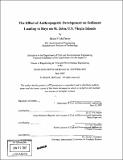| dc.contributor.advisor | E. Eric Adams and Peter Shanahan. | en_US |
| dc.contributor.author | McCreery, Helen F | en_US |
| dc.contributor.other | Massachusetts Institute of Technology. Dept. of Civil and Environmental Engineering. | en_US |
| dc.coverage.spatial | nwvi--- | en_US |
| dc.date.accessioned | 2007-10-22T17:28:21Z | |
| dc.date.available | 2007-10-22T17:28:21Z | |
| dc.date.issued | 2007 | en_US |
| dc.identifier.uri | http://hdl.handle.net/1721.1/39267 | |
| dc.description | Thesis (M. Eng.)--Massachusetts Institute of Technology, Dept. of Civil and Environmental Engineering, 2007. | en_US |
| dc.description | "June 2007." | en_US |
| dc.description | Includes bibliographical references (p. 62-67). | en_US |
| dc.description.abstract | In order to assess the impact of anthropogenic development on sediment delivery rates to bays on St. John, U.S.V.I., I developed a sediment loading prediction model. Based on the modified universal soil loss equation, this model predicts sediment loading using watershed parameters, including the soil type, topography, and land use of the watershed, and also storm based parameters, including the total storm runoff and peak discharge. Sediment loads I predicted on a storm-by-storm basis, and annual sediment loads were calculated by summing the loads from each storm in a year. This was performed from historical rainfall data for three years: 1990, which had an approximately average total rainfall; 1986, which had the highest total rainfall in the period for which I had rainfall data; and 1989, which was the year of Hurricane Hugo, and therefore had the largest single storm. I calculated sediment loads for multiple bays, with varying levels of development. The sediment loads to the developed bays were as much as or even more than an order of magnitude greater than sediment loads to undeveloped bays. Additionally, I calculated the sediment loads to each bay under entirely undeveloped conditions, comparing these loads to the loads under current development conditions. Again, developed conditions often resulted in a sediment load at least ten times greater than the load under no development. | en_US |
| dc.description.statementofresponsibility | by Helen F. McCreery. | en_US |
| dc.format.extent | 83 p. | en_US |
| dc.language.iso | eng | en_US |
| dc.publisher | Massachusetts Institute of Technology | en_US |
| dc.rights | M.I.T. theses are protected by copyright. They may be viewed from this source for any purpose, but reproduction or distribution in any format is prohibited without written permission. See provided URL for inquiries about permission. | en_US |
| dc.rights.uri | http://dspace.mit.edu/handle/1721.1/7582 | |
| dc.subject | Civil and Environmental Engineering. | en_US |
| dc.title | The effect of anthropogenic development on sediment loading to bays on St. John, U.S. Virgin Islands | en_US |
| dc.type | Thesis | en_US |
| dc.description.degree | M.Eng. | en_US |
| dc.contributor.department | Massachusetts Institute of Technology. Department of Civil and Environmental Engineering | |
| dc.identifier.oclc | 170820672 | en_US |
